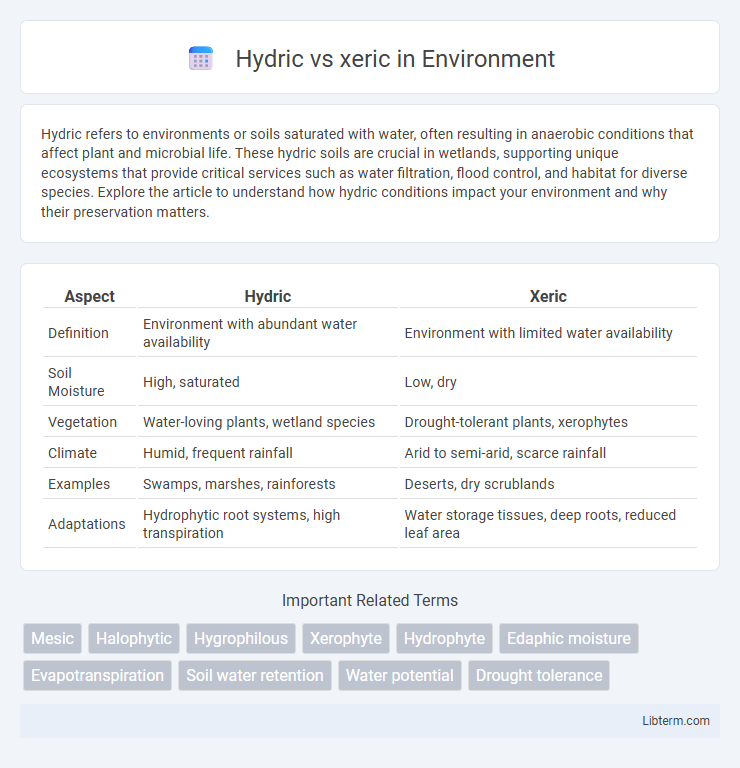Hydric refers to environments or soils saturated with water, often resulting in anaerobic conditions that affect plant and microbial life. These hydric soils are crucial in wetlands, supporting unique ecosystems that provide critical services such as water filtration, flood control, and habitat for diverse species. Explore the article to understand how hydric conditions impact your environment and why their preservation matters.
Table of Comparison
| Aspect | Hydric | Xeric |
|---|---|---|
| Definition | Environment with abundant water availability | Environment with limited water availability |
| Soil Moisture | High, saturated | Low, dry |
| Vegetation | Water-loving plants, wetland species | Drought-tolerant plants, xerophytes |
| Climate | Humid, frequent rainfall | Arid to semi-arid, scarce rainfall |
| Examples | Swamps, marshes, rainforests | Deserts, dry scrublands |
| Adaptations | Hydrophytic root systems, high transpiration | Water storage tissues, deep roots, reduced leaf area |
Understanding Hydric and Xeric Environments
Hydric environments are characterized by saturated soils with abundant water, typically found in wetlands, marshes, and floodplains, supporting moisture-loving plant species such as cattails and sedges. Xeric environments feature dry, well-drained soils with limited water availability, common in deserts and arid regions, where drought-tolerant vegetation like cacti and sagebrush thrives. Understanding the distinct soil moisture conditions and associated flora in hydric versus xeric habitats is crucial for ecosystem management and conservation efforts.
Key Characteristics of Hydric Habitats
Hydric habitats are defined by saturated soils or standing water, creating oxygen-poor conditions that support anaerobic microorganisms and specialized plant species such as sedges, cattails, and water lilies. These environments often include wetlands, marshes, swamps, and bogs, characterized by high soil moisture content, periodic flooding, and organic-rich substrates that slow decomposition. The unique hydrology and soil chemistry of hydric habitats promote biodiversity by providing critical breeding grounds and resources for amphibians, aquatic invertebrates, and waterfowl.
Defining Features of Xeric Ecosystems
Xeric ecosystems are characterized by low moisture availability, often found in arid or semi-arid regions where annual precipitation is minimal and evaporation rates are high. Vegetation in xeric environments typically includes drought-resistant plants such as cacti, succulents, and xerophytes with adaptations like deep root systems and reduced leaf surfaces to conserve water. Soil in these ecosystems tends to be sandy or rocky with low organic content, limiting water retention and influencing the specialized flora and fauna adapted to survive in harsh, water-scarce conditions.
Water Availability: The Core Difference
Hydric environments are characterized by abundant water availability, frequently saturated soils, and high moisture levels that support wetland vegetation and aquatic ecosystems. Xeric environments contain minimal water availability, often featuring dry, sandy, or rocky soils with sparse vegetation adapted to drought conditions. Water availability fundamentally distinguishes these two habitats, influencing soil properties, plant communities, and overall ecosystem dynamics.
Plant Adaptations in Hydric vs Xeric Settings
Plants in hydric environments exhibit adaptations such as aerenchyma tissue for oxygen transport, shallow root systems, and tolerance to waterlogged soils. Xeric plants develop thick cuticles, deep root systems, and water storage tissues like succulence to survive intense drought and minimal water availability. These physiological and structural adaptations optimize survival by balancing water uptake and loss in contrasting moisture conditions.
Animal Life in Hydric and Xeric Regions
Animal life in hydric regions thrives with species adapted to abundant water environments, such as amphibians, waterfowl, and aquatic mammals that rely on wetlands, rivers, and lakes for survival. Xeric regions support fauna like reptiles, small mammals, and insects adapted to arid conditions, exhibiting physiological and behavioral traits to conserve water and withstand extreme temperatures. Biodiversity in hydric areas tends to be higher due to stable moisture levels, while xeric ecosystems feature specialized species able to endure drought and sparse vegetation.
Soil Composition and Properties
Hydric soils are characterized by high moisture content and significant organic matter accumulation, resulting in low oxygen levels and anaerobic conditions ideal for wetland vegetation. Xeric soils, in contrast, are dry with coarse texture, low organic content, and high mineral concentration, leading to rapid drainage and limited water retention. The distinct differences in hydric and xeric soil composition directly influence nutrient availability and microbial activity essential for plant growth in their respective ecosystems.
Hydric and Xeric Examples Around the World
Hydric environments, characterized by abundant water availability, include wetlands like the Florida Everglades in the United States and the Okavango Delta in Botswana. Xeric environments, defined by extreme dryness, are exemplified by the Sahara Desert in North Africa and the Atacama Desert in Chile. These ecosystems demonstrate how water availability shapes biodiversity and vegetation patterns globally.
Human Impact on Hydric and Xeric Areas
Human impact on hydric areas often leads to wetland drainage, pollution, and habitat loss, severely disrupting water filtration and biodiversity. In xeric regions, activities such as overgrazing, deforestation, and urbanization accelerate soil erosion and desertification, reducing native plant and animal populations. Both hydric and xeric ecosystems suffer from land-use changes that compromise their ecological functions and resilience.
Importance of Conserving Both Habitat Types
Conserving hydric and xeric habitats is crucial for maintaining biodiversity, as water-rich wetlands support amphibians and aquatic plants, while dry xeric environments provide refuge for drought-adapted species and unique flora. Both habitat types regulate ecological processes, with hydric areas controlling floodwaters and xeric zones preventing desertification. Protecting these ecosystems ensures resilience against climate change and supports essential services like water filtration and carbon sequestration.
Hydric Infographic

 libterm.com
libterm.com